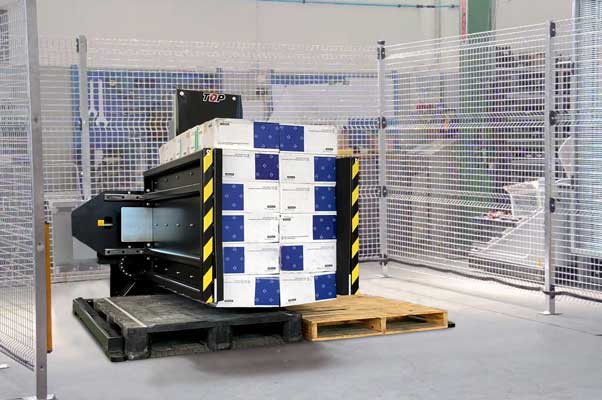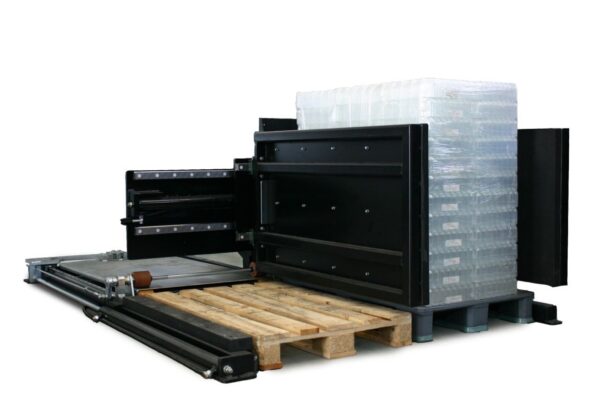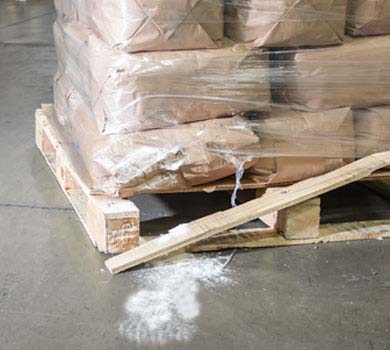
TopIndustries does not only deal with the supply of pallet exchangers, but with everything that the company may need in the moment of production and storage. A well-stocked, tidy, controlled, and clean warehouse is essential for all companies, and especially for those who work in the food and pharmaceutical sectors. It is very important that everything is stored correctly, and more and more companies decide to replace the use of wooden pallets vs plastic pallets.
The reasons are many and varied, and we would like to give a quick overview of some of the main reasons. Now we explain why!
Let’s start with environmental sustainability reasons: plastic pallets are more ecological and convenient, as the black pallets are printed using polyethylene or polypropylene from regenerated materials, transforming waste into a resource, and at the end of their life cycle they can in turn be recycled. The white pallets, on the other hand, can be printed with virgin material to obtain the certifications of suitability for contact with food. The wooden platforms are produced every time starting from scratch, using virgin material that comes from the felling of trees.
Why wooden pallet vs plastic pallet?
Plastic pallets are more hygienic: while wooden pallets must comply with phytosanitary regulations and always be subjected to a sterilizing treatment, since wood is a refuge for microorganisms such as bacteria, fungi, insects, larvae and parasites, plastic pallets do not they fear their attack. Their hygienic integrity allows you to store goods outdoors, since there is no risk of infiltration of moisture and pests in the material.
Plastic pallets are an excellent alternative to traditional wooden pallets because as well as being more hygienic, they are certainly safer and more durable over time. Even more so, if we compare them with wooden pallets certified according to the ISPM-15 standard, which is mandatory in many countries of the world, they are even cheaper!

The ISPM-15 standard imposed on wooden pallets
The FAO (Food and Agriculture Organization of the United Nations) has issued a regulation on packaging that concerns boxes, crates, tubs, drums, and even pallets made of raw wood. The raw wood is in fact subject to deterioration, the nails that fix the various boards can rust and small splinters of the structure can come off and compromise the goods. To guarantee high sanitary standards, wooden pallets used for international transport must undergo heat treatment and thus obtain the IPPC or HT mark. This is one of the main reasons why food or pharmaceutical companies rely on us for pallet changing solutions. Generally, depending on the request, we provide mobile or stationary pallet exchanger solutions or logistics lines with roller conveyors that carry out the pallet replacement operation in a fully automated manner.
Where is this legislation governing wooden pallets applied?
The ISPM-15 standard is required by all countries that have signed up to the international standard for phytosanitary measures – International Standards for Phytosanitary Measures -, such as Canada, United States, Brazil, China, Japan, India, Algeria, Tunisia, Australia and many others.

Replacing wooden pallet vs plastic pallet is the solution!
The heat treatments to which the wood is subjected increases production costs and obviously the final cost of the pallet. Compared to raw wooden pallets, plastic pallets are certainly cheaper. In order to store products within the logistics centers and comply with hygiene and health standards, the wooden pallets must be replaced with plastic, which is why we provide pallet changing solutions all over the world.
For international transport, companies are inclined to purchase plastic pallets because they are easy to sanitize, have no details that can rust, do not release splinters, and fully comply with FAO requirements without the need for additional treatments and branding.
Are you looking for a pallet exchanger?
Are you looking for a machine that offers high levels of automation without the need to employ operators? Contact us at 1-754-271-4310 and request a quote now! Our production range includes over 50 types of pallet turner / pallet inverter capable of replacing the pallet for all types of products, by tipping the load, applying side pressure, or lifting the load.

The difference between wooden pallets vs plastic pallets
It is fair to say that pallets are a fundamental component in moving products around the world as they play a supporting role for goods during transport and are extremely important throughout the supply and storage chain. Typically, pallets are made of wood or plastic, with the vast majority still wood. Both materials have advantages and disadvantages and we then illustrate the objective differences so that you will have a clearer view when you need to make an investment in your business.
Plastic Pallets
Plastic pallets are generally used in the transportation of fresh food, frozen food, pharmaceutical products, or any other product with strict sanitation requirements. Plastic pallets are non-porous and are easy to clean, wash and sterilize. This is one of the main reasons plastic pallets are around three times more expensive than wooden pallets, enjoying advanced features and superior benefits. In fact, plastic pallets are lighter and their smooth surface makes them less slippery and less stable for stacking.
If you have a business that ships products abroad that are leaving without the possibility of being returned or reused, expensive plastic pallets are unlikely to be the right economic choice.
Although plastic pallets have always been considered environmentally friendly, they cannot be easily repaired. However, they have a significantly longer shelf life than wooden pallets. In fact, the main advantage of plastic pallets is that they can be reused for a long time without breaking. They are perfectly designed for storage and reuse of warehouses. They are considered elegant, certainly light, free of splinters, and suitable for manual handling. Their shape makes them ideal for use on pallet wrapping machines or pallet changers.

Wooden Pallets
On the other hand, wooden pallets are about three times more expensive than plastic pallets and at least ten times more used. They are heavier than plastic pallets and can be repaired and reused. However, they are not ideal for fragile items as the fasteners used in wooden pallets can damage the goods. The nails that are used to fix the wooden planks and compose the pallet, can pose a puncture hazard. For example, try an image of a sack of flour that is punctured during handling: it would cause a waste of time as operators would have to clean and there could be a delay in delivery. At the expense of wooden pallets, it must definitely be said that they do not have the same degree of fire safety as plastic. Plastic pallets burn at a much higher temperature than wood, which is why it is recommended that you check fire codes when deciding which pallet to buy.

In summary, there are several advantages and disadvantages in using the two types of pallets but one thing is certain: companies need to change the pallet and the demand for machinery capable of doing this is constantly increasing. TopIndustries is the world leader in the supply of pallet changing solutions, do not hesitate to contact us, a team of experts will be at your complete disposal!
